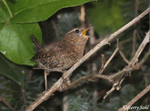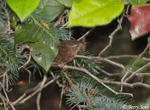Pacific and Winter Wrens
Troglodytes pacificus (Pacific Wren) and Troglodytes hiemalis (Winter Wren)
| Length: 4 inches | Wingspan: 6 inches | Seasonality: Migrant / Winter |
| ID Keys: Very small, dark brown overall, heavy dark barring on flanks, short tail. | ||
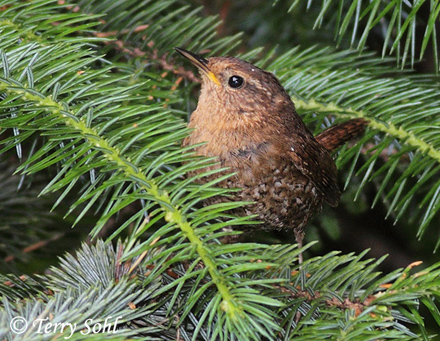 Prior
to 2010, "Troglodytes troglodytes", the "Winter Wren", was considered one
species. However, research revealed a genetic split between the wrens
found in the western North America, eastern North America, and Eurasia.
They were split into three distinct species in 2010, with the two North American
populations named Pacific Wren and Winter Wren. The Pacific Wren is found
in the humid forests of the Pacific Northwest, while the Winter Wren is found in
eastern North America. Research indicates a genetic split between the two
species going back at least 4 million years, and evidently the two populations
do not commonly interbreed. They are distinctly separated by geography,
and South Dakota is one area where both the Pacific and Winter Wrens may be
seen, with Pacific Wrens likely found in the Black Hills, while those birds
found in the eastern part of the state are likely Winter Wrens.
Prior
to 2010, "Troglodytes troglodytes", the "Winter Wren", was considered one
species. However, research revealed a genetic split between the wrens
found in the western North America, eastern North America, and Eurasia.
They were split into three distinct species in 2010, with the two North American
populations named Pacific Wren and Winter Wren. The Pacific Wren is found
in the humid forests of the Pacific Northwest, while the Winter Wren is found in
eastern North America. Research indicates a genetic split between the two
species going back at least 4 million years, and evidently the two populations
do not commonly interbreed. They are distinctly separated by geography,
and South Dakota is one area where both the Pacific and Winter Wrens may be
seen, with Pacific Wrens likely found in the Black Hills, while those birds
found in the eastern part of the state are likely Winter Wrens.
Both birds are fond of dense forest undergrowth, often staying out of sight as they forage along the ground through thickets and fallen logs. While often difficult to spot, during breeding season the males will sometimes flit up to higher perches to sing extremely long complex songs, lasting 6-8 seconds or more and consisting of over a hundred separate notes. In addition to genetic differences and differences in range, the males' songs also are distinctly different between the two populations. Note the photo to the right is of a Pacific Wren, taken along the Oregon Coast, while the photo found below is of a Winter Wren. All of the "additional photos" found at the bottom of the page are of Pacific Wrens.
Habitat: During the summer breeding season, they are primarily found in moist conifer forests with a dense understory, often near water. They winter in similar forest habitats with dense understories, although they will use deciduous and mixed forests as well as conifer forests.
Diet: Primarily feeds on insects and spiders, as well as snails, millipedes, tiny fish, and berries.
Behavior: Often forages low in dense thickets and undergrowth, in vegetation and also along the ground. They may also occasionally forage along streams and pick items from the water's surface. Unlike some other wren species, both Pacific and Winter Wrens tend to utilize heavy cover even when males are furiously singing their territorial songs. The birds are often much easier to hear than see.
Breeding: Non-breeder in South Dakota
Song: A very high-pitched notes with rapid trilling interspersed. Click here to listen to the Winter Wren's song. Click here for the Winter Wren's call.
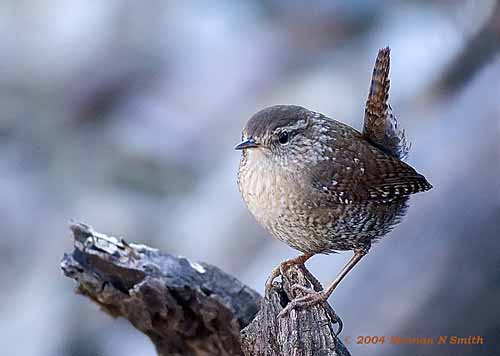 Migration:
Even prior to the species split into Pacific and Winter Wrens, major differences
were found between migration patterns in western and eastern birds.
Pacific Wrens are primarily permanent
residents along much of the Pacific Coast, all the way up to through the southern coast
of Alaska, although some movements to lower elevations may occur in the fall.
Winter Wrens
summer in the southern half of Canada, the Great Lakes region, and New
England, while wintering in the eastern U.S. as far north as Illinois, Ohio,
and New York and southward to the Gulf Coast. Some Winter Wrens are also
evidently permanent residents in parts of the Appalachians.
Migration:
Even prior to the species split into Pacific and Winter Wrens, major differences
were found between migration patterns in western and eastern birds.
Pacific Wrens are primarily permanent
residents along much of the Pacific Coast, all the way up to through the southern coast
of Alaska, although some movements to lower elevations may occur in the fall.
Winter Wrens
summer in the southern half of Canada, the Great Lakes region, and New
England, while wintering in the eastern U.S. as far north as Illinois, Ohio,
and New York and southward to the Gulf Coast. Some Winter Wrens are also
evidently permanent residents in parts of the Appalachians.
Interactive eBird Maps: Click here to access an interactive eBird map for Pacific Wren sightings. Click here to access an interactive eBird map for Winter Wren sightings.
Similar Species: House Wren
Conservation Status: Numbers appear to be stable.
Further Information: 1) Wikipedia - Winter Wren
2) Cornell Lab of Ornithology - Winter Wren
4) Audubon Guide - Pacific Wren
Photo Information: Top Photo (Pacific Wren) - Ecola State Park, Oregon - June 29, 2011 - Terry Sohl
Bottom Photo (Winter Wren) - Out-of-state photo, Courtesy of Norman Smith.
| Click on the map below for a higher-resolution view |
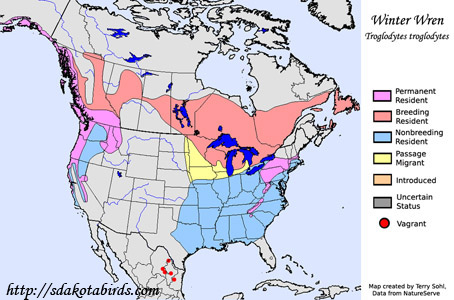 |
| South Dakota Status: Rare to uncommon migrant, casual in winter. Note the now split "Pacific Wren" is likely found in the Black Hills, while the split "Winter Wren" is the species likely found in the eastern part of South Dakota in the winter. However, given the recent split of the species, additional research is likely required to confirm this. The map above represents North American populations of both Pacific and Winter Wrens. |
Additional Pacific and Winter Wren Photos
Click for a higher-resolution version of these photos

